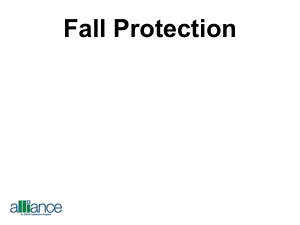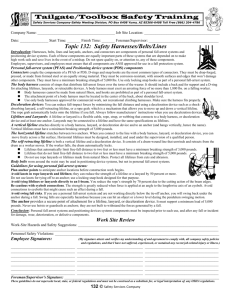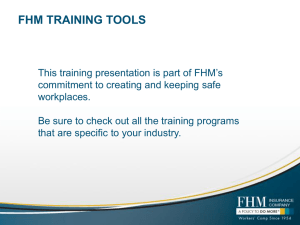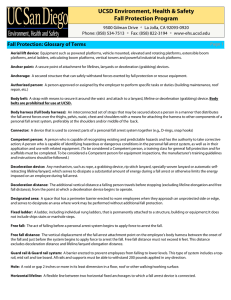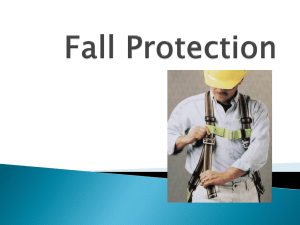WKU Fall Protection Plan: Safety Guidelines & Training
advertisement
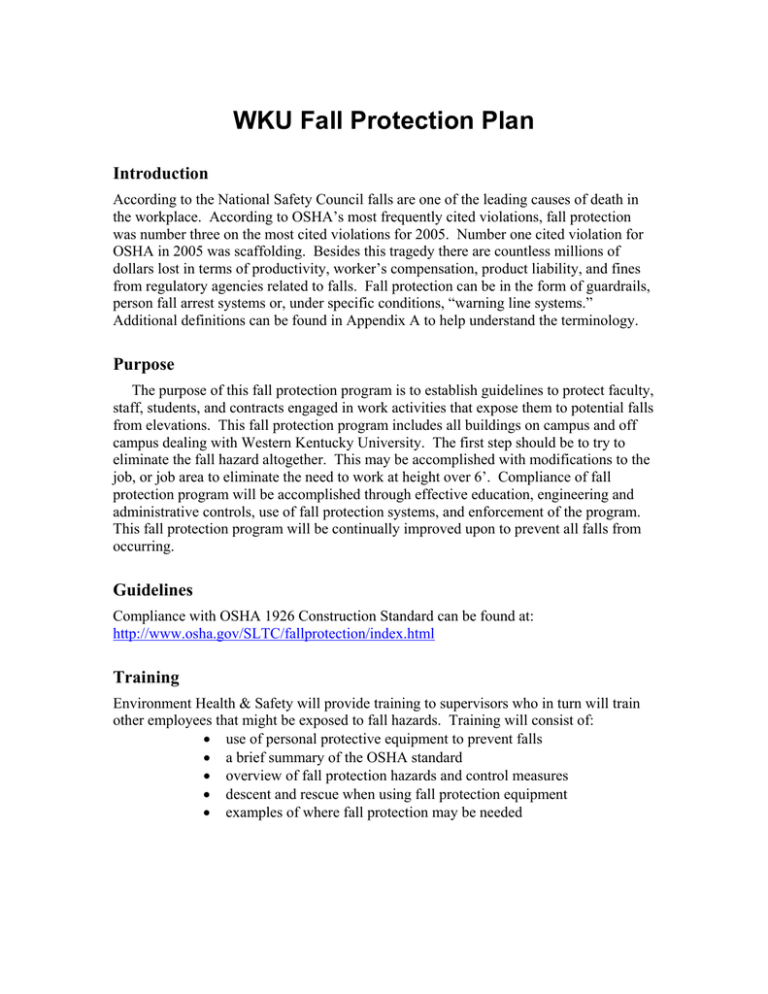
WKU Fall Protection Plan Introduction According to the National Safety Council falls are one of the leading causes of death in the workplace. According to OSHA’s most frequently cited violations, fall protection was number three on the most cited violations for 2005. Number one cited violation for OSHA in 2005 was scaffolding. Besides this tragedy there are countless millions of dollars lost in terms of productivity, worker’s compensation, product liability, and fines from regulatory agencies related to falls. Fall protection can be in the form of guardrails, person fall arrest systems or, under specific conditions, “warning line systems.” Additional definitions can be found in Appendix A to help understand the terminology. Purpose The purpose of this fall protection program is to establish guidelines to protect faculty, staff, students, and contracts engaged in work activities that expose them to potential falls from elevations. This fall protection program includes all buildings on campus and off campus dealing with Western Kentucky University. The first step should be to try to eliminate the fall hazard altogether. This may be accomplished with modifications to the job, or job area to eliminate the need to work at height over 6’. Compliance of fall protection program will be accomplished through effective education, engineering and administrative controls, use of fall protection systems, and enforcement of the program. This fall protection program will be continually improved upon to prevent all falls from occurring. Guidelines Compliance with OSHA 1926 Construction Standard can be found at: http://www.osha.gov/SLTC/fallprotection/index.html Training Environment Health & Safety will provide training to supervisors who in turn will train other employees that might be exposed to fall hazards. Training will consist of: use of personal protective equipment to prevent falls a brief summary of the OSHA standard overview of fall protection hazards and control measures descent and rescue when using fall protection equipment examples of where fall protection may be needed Retraining Retraining is needed: When a worker demonstrates that they lack the knowledge necessary to use the protective system in accordance with the manufacturer’s recommendations. Changes in the workplace render previous training obsolete When there are changes in types of fall protection being used When not following necessary precautions Engineering and Administrative Controls Supervisors shall determine if engineering controls can eliminate or lessen the hazard of the work area or job site. Engineering controls shall be provided where possible to minimize fall hazards. Engineering controls of fall hazards consist of the following: Guardrails and Toeboards: Located within OSHA Construction standard 1926.502 (b) through 1926.502 (b)(15) These requirements apply to temporary controls on job sites as well as permanent fixtures in general work areas. A. Guardrail systems include top rails, midrails, and toeboards. Top edge height of the top rails shall be 42” plus or minus 3 inches from the top of the rail to the floor, platform, runway or ramp. Nominal height of the midrail is 21 inches; B. Standard toe boards must be equivalent in strength to 1 inch by 4 inch lumber or 1 ¼ “ by 1 ¼” by 1/8 inch structural angle iron and no more than ¼ inch clearance to the floor. If a mesh material is used, the opening must be less that 1 inch; C. The anchoring of posts and framing of members for railings of all types must be of such construction that the completed structure is capable of withstanding a load of 200 pounds applied in any direction at any point on the top rail; D. Guardrail systems have a surface that prevents injuries such as punctures and lacerations and prevents snagging of clothing; and E. When guardrail systems are in hoisting areas, a chain gate or removable guardrail section shall be in place when not being used. Skylights Located within OSHA Construction standard 1926.501 (b(4)) through 1926.501 (b)(4)(iii) and OSHA General Industry standard 1910.23(a)(4). A. The Skylights that may be used as a walking or working surface must be protected by a standard railing, standard skylight screen, grill work with 4 by 4 inch openings or slat work with 2-inch openings; and B. Standard skylight screens must be capable of withstanding minimum load of 200 pounds applied perpendicular to any point on the screen and will not deflect under ordinary loads and impacts and break glass. Covers Located within OSHA General Industry standard 1910.23(e)(7)(i-iii) and OSHA Construction standard 1926.502(i) to 1926.502(i)(4) A. Covers for holes, including grates, shall be capable of supporting, without failure, at least twice the weight of employees, equipment, and materials that may be imposed on the cover at any one time; B. Covers located on roadways and vehicular aisles shall be capable of supporting, without failure, at least twice the maximum axle load of the largest vehicle expected to cross over it; C. All covers shall be secured when installed so as to prevent accidental displacement by the wind, equipment, or employees; D. Covers shall be marked with the word "Hole" or "Cover" to provide warning of the hazard when it is not readily apparent; and E. While a cover is not in place, the pit or trap opening shall be constantly attended by someone or shall be protected on all exposed sides by removable standard railings. Safety Monitoring Systems - 1926.502(h) When no other fall protection is feasible, the employer shall implement a safety monitoring system. Employers must appoint a competent person to monitor the safety of workers and the employer shall ensure that the safety monitor: A. Is competent in the recognition of fall hazards, B. Is capable of warning workers of fall hazard dangers and in detecting unsafe work practices, C. Is operating on the same walking/working surfaces of the workers and can see them, and D. Is close enough to work operations to communicate orally with workers and has no other duties to distract from the monitoring function. Mechanical equipment shall not be used or stored in areas where safety monitoring systems are being used to monitor employees engaged in roofing operations on lowsloped roofs. No worker, other than one engaged in roofing work (on low sloped roofs) or one covered by a fall protection plan, shall be allowed in an area where an employee is being protected by a safety monitoring system. All workers in a controlled access zone shall be instructed to promptly comply with fall hazard warnings issued by safety monitors. Warning Line Systems - 1926.502(f) Warning line systems consist of ropes, wires, or chains, and supporting stanchions and are set up as follows: A. Flagged at no more than 6-foot (1.8 meters) intervals with high-visibility material. B. Rigged and supported so that the lowest point including sag is no less than 34 inches (0.9 meters) from the walking/ working surface and its highest point is no more than 39 inches (1 meter) from the walking/working surface. C. Stanchions, after being rigged with warning lines, shall be capable of resisting, without tipping over, a force of at least 16 pounds (71 Newtons) applied horizontally against the stanchion, 30 inches (0.8 meters) above the walking/working surface, perpendicular to the warning line and in the direction of the floor, roof, or platform edge. D. The rope, wire, or chain shall have a minimum tensile strength of 500 pounds (2.22 kilo Newtons), and after being attached to the stanchions, must support without breaking the load applied to the stanchions as prescribed above. E. Shall be attached to each stanchion in such a way that pulling on one section of the line between stanchions will not result in slack being taken up in the adjacent section before the stanchion tips over. Warning lines shall be erected around all sides of roof work areas. When mechanical equipment is being used, the warning line shall be erected not less than 6 feet (1.8 meters) from the roof edge parallel to the direction of mechanical equipment operation, and not less than 10 feet (3 meters) from the roof edge perpendicular to the direction of mechanical equipment operation. When mechanical equipment is not being used, the warning line must be erected not less than 6 feet (1.8 meters) from the roof edge. Fall Protection Personal Protective Equipment Personal protective equipment shall be used to minimize fall hazards where engineering controls do not eliminate the hazard or in conjunction with engineering controls. Fall protection equipment is divided into four functional categories: 1. Fall Arrest, 2. Positioning, 3. Retrieval, & 4. Restraint. I. Fall Arrest The use of a personal fall arrest system is the required personal protective equipment for fall hazards. A personal fall arrest system consists of a full-body harness, lanyard, and anchor point OR a full-body harness, lanyard, lifeline, anchor point, and deceleration/grabbing device. All fall protection equipment shall meet or exceed appropriate American National Standards Institute (ANSI) standards. Western Kentucky University employees shall use only commercially manufactured equipment specifically designed for fall protection and certified by a nationally recognized testing laboratory. All fall protection equipment must bear the marking of the manufacturer and approvals for specified use. Requirements for a personal fall arrest system include but are not limited to the following: A. Body Harness - Only full-body harnesses shall be used. The use of a body belt is prohibited. B. Connecting Device - Shock-absorbing lanyards and lifelines 1. Lanyards and lifelines shall have a minimum breaking strength of 5000 pounds; 2. Lanyards shall not exceed six feet in length. Lanyards used on aerial lift devices should not exceed 4 feet in length to reduce slack; 3. Ropes and straps (webbing) used in lanyards, lifelines, and strength components of body harnesses shall be made from synthetic fibers; 4. Connecting assemblies shall have a minimum tensile strength of 5,000 pounds; 5. Self-retracting lifelines and lanyards shall have a tensile strength of at least 3000 pounds and limit free fall to two feet or less (5,000 pounds for ripstich lanyards, and tearing and deforming lanyards); 6. Personal fall arrest systems shall limit the maximum arresting forces to 1800 pounds with a full body harness; 7. The maximum free fall distance is six feet for all systems; 8. The maximum deceleration distance is 3.5 feet; 9. Personal fall arrest systems shall have sufficient strength to withstand twice the potential impact energy of the falling employee; 10. Lifelines shall be protected against cutting and abrasions; 11. Horizontal lifelines shall be designed, installed and used under the supervision of a qualified person, as part of a complete personal fall arrest system, which maintains a safety factor of two. On suspended scaffolds or similar work platforms with horizontal lifelines which may become vertical lifelines, the devices used to connect to a horizontal lifeline shall be capable of locking in both directions on the lifeline; and 12. Each employee shall be attached to a separate lifeline when vertical lifelines are used. On suspended scaffolds or similar work platforms with horizontal lifelines which may become vertical lifelines, the devices used to connect to a horizontal lifeline shall be capable of locking in both directions on the lifeline. C. Anchorage - Anchorage point and anchorage connector 1. Anchorages used for personal fall arrest systems shall be independent of any anchorage being used to support or suspend platforms and be capable of supporting at least 5000 pounds per employee attached, or shall be designed, installed (temporarily or permanently), and used as part of a complete fall arrest system which maintains a factor of two and under the supervision of a qualified person; 2. A qualified person shall determine all anchor points, both temporary and permanent. Permanent anchor points shall be properly marked; 3. Personal fall arrest systems shall not be attached to guardrail systems, nor shall they be attached to hoists except as specified in other regulations. II. Positioning A positioning device is not a substitute for a personal arrest system and is limited to use as system rigged to allow an employee to be supported on an elevated vertical surface, such as a wall, and work with both hands free while leaning. Where positioning device is used, it shall comply with the following: A. Only a full-body harness shall be worn as part of a positioning device system. Body belts are not acceptable; B. Positioning devices shall be rigged such that a free fall cannot be more than 2 feet; and C. Positioning devices shall be secured to an anchorage point capable of supporting at least twice the potential impact load of an employee’s fall or 3,000 lbs, whichever is greater. III. Retrieval Personal retrieval systems are used for confined space entry and on-entry rescue. Refer to the Confined Spaces Plan for information on confined spaces entry. Personal retrieval systems consist of the following: A. Full body hardness B. Retractable lifeline/rescue unit; and C. Tripod IV. Restraint A restraint line is a device which is attached between the employee and an anchorage point to prevent the employee from walking or falling off an elevated surface. It does not support an employee at an elevated surface, but rather, prevents the employee from leaving the elevated surface or work position. Personal Fall Protection Systems All employees on any project that will be required to wear a personal fall arrest or restraint system will follow these guidelines: 1) A full body harness will be used at all times. 2) All personal fall arrest systems will be inspected before each use by the employee. Any deteriorated, bent, damaged, impacted and/or harness showing excessive wear will be removed from service. 3) Connectors will be inspected to ensure they are drop forged, pressed, or formed steel or are made of equivalent materials and that they have a corrosion resistant finish as 4) 5) 6) 7) 8) well as that all surfaces and edges are smooth to prevent damage to interfacing parts of the system. Verify that D rings and snap hooks have a minimum tensile strength of 5,000 lbs and that the D rings and snap hooks are proof tested to a minimum tensile load of 3,600 lbs without cracking, breaking, or taking permanent deformation. Only shock absorbing lanyards or retractable lanyards are to be used so as to keep impact forces at a minimum on the body (fall arrest systems). Only nylon rope or nylon straps with locking snaphooks are to be used for restraints. All lanyards will have self-locking snaphooks. Verify that unintentional disengagement of snap hooks is prevented by either of the following means: a) Snap hooks are a compatible size for the member to which they are connected locking type snap hooks are used. Inspection and Maintenance for Harness and lanyards Information can be found at: http://www.osha.gov/Region7/fallprotection/fall_protection_info.html Effective January 1, 1998, only locking type snap hooks may be used. Verify that unless the snap hook is a locking type and is designed for the following connections, snap hooks are not engaged in the following manners: i) ii) iii) iv) directly to webbing, rope, or wire rope; to each other; to a D ring to which another snap hook or other connector is attached; to a horizontal lifeline; or to any object that is incompatibly shaped or dimensioned in relation to the snap hook such that unintentional disengagement could occur by the connected object being able to depress the snap hook keeper and release itself. The maximum free fall distance is not to exceed 6 feet. Consideration must be given to the total fall distance. The following factors can affect total fall distance: 1. 2. 3. 4. 5. 6. Length of connecting means (i.e., lanyard length, use of carabineers, snaphooks, etc.). Position and height of anchorage relative to work platform/area (always keep above head whenever possible). Position of attachment and D-ring slide on the full body harness. Deployment of shock absorber (max 42”). Movement in lifeline. Initial position of worker before free fall occurs (i.e., sitting, standing, etc.). Calculating Total Fall Distance It is the total length of shock absorbing lanyard + height of the person + the location distance of the D-ring from the work surface or platform. Always allow a minimum of 6 feet of clearance above the ground, equipment, etc., at the end of the fall from the fall arrest point. Storage and Maintenance of Fall Protection Equipment 1. 2. 3. 4. 5. 6. 7. 8. 9. 10. Never store the personal fall arrest equipment in the bottom of a tool box, on the ground, or outside exposed to the elements (i.e., sun, rain, snow, etc.). Hang equipment in a cool dry location in a manner that retains its shape. Always follow manufacturer recommendations for inspection. Clean with a mild, nonabrasive soap, and hang to dry. Never force dry or use strong detergents in cleaning. Never store equipment near excessive heat, chemicals, moisture, or sunlight. Never store in an area with exposures to fumes or corrosives elements. Avoid dirt and build-up on equipment. Never use this equipment for any purpose other than personal fall arrest. Once exposed to a fall, remove equipment from service immediately Aerial Lifts A. On all rented lifts consult operator’s manual before using to ensure capability of rescue techniques B. There must be at least two employees present when using a lift, where one employee is available to help in case of fall. C. Aerial ladders shall be secured in the lower traveling position before the truck is moved for highway travel; D. Lift controls shall be tested each day prior to use; E. Only personnel who have been trained, issued an operational card,(must be with you when operating the lift) and wearing fall protection shall operate an aerial lift: F. Employees shall always stand firmly on the floor of the basket and shall not sit or climb on the edge of the basket or use planks, ladders, or other devices for a work position; G. A full-body harness shall be worn and a lanyard attached to the boom or basket when working from an aerial lift (exception: a harness is not required in a scissor lift or personal man lift with surrounding guardrail system and closing gate or latch chain); H. Belting off to an adjacent pole structure, or equipment while working from an aerial lift shall not be permitted; I. Boom and basket load limits specified by the manufacturer shall not be exceeded; J. The brakes shall be set and when outriggers are used, they shall be positioned on pads or other solid surface. Wheel chocks shall be installed when using an aerial lift on an incline; K. An aerial lift truck shall not be moved when the boom is elevated in a working position, except for equipment which is specifically designed for this type of operation; L. Before moving an aerial lift for travel, the boom shall be inspected to ensure that it is properly cradled and outriggers are in the stowed position. Rescue Before anyone attempts an aerial lift, there must be a plan in place for rescue should an employee fall. In the event that the rescue plan could endanger the fallen employee, call 911 to initiate the rescue process. Appendix A - Definitions Aerial Device – Any vehicle-mounted device, telescoping or articulating, or both, which is used to position personnel. Aerial Ladder – An aerial device consisting of a single- or multiple-section extensible ladder. Anchorage — A secure point of attachment for lifelines, lanyards or deceleration devices. Body belt — A strap with means both for securing it about the waist and for attaching it to a lanyard, lifeline, or deceleration device. Body harness — Straps that may be secured about the person in a manner that distributes the fall-arrest forces over at least the thighs, pelvis, waist, chest, and shoulders with a means for attaching the harness to other components of a personal fall arrest system. Competent Person—One who is capable of identifying existing and predictable hazards in the surroundings or working conditions which are unsanitary, hazardous, or dangerous to employees, and who has authorization to take prompt corrective action. Connector — A device that is used to couple (connect) parts of a personal fall arrest system or positioning device system together. Controlled access zone — A work area designated and clearly marked in which certain types of work (such as overhand bricklaying) may take place without the use of conventional fall protection systems—guardrail, personal arrest or safety net—to protect the employees working in the zone. Deceleration device — Any mechanism—such as rope, grab, ripstitch lanyard, speciallywoven lanyard, tearing or deforming lanyards, automatic self-retracting lifelines/lanyards —which serves to dissipate a substantial amount of energy during a fall arrest, or otherwise limits the energy imposed on an employee during fall arrest. Deceleration distance — The additional vertical distance a falling person travels, excluding lifeline elongation and free fall distance, before stopping, from the point at which a deceleration device begins to operate. Extensible boom platform. – An aerial device (except ladders) with a telescopic or extensible boom. Telescopic derricks with personnel platform attachments shall be considered to be extensible boom platforms when used with a personnel platform. Fall Restraint System – Means a system that is used to prevent an employee from falling any distance consisting of an anchorage, connectors, and a body belt or harness; and may include, lanyards, lifelines, or rope grabs designed for that purpose. Guardrail system — A barrier erected to prevent employees from falling to lower levels. Hole — A void or gap 2 inches (5.1 centimeters) or more in the least dimension in a floor, roof, or other walking/working surface. Lanyard — A flexible line of rope, wire rope, or strap that generally has a connector at each end for connecting the body belt or body harness to a deceleration device, lifeline, or anchorage. Leading edge — The edge of a floor, roof, or formwork for a floor or other walking/working surface (such as the deck) which changes location as additional floor, roof, decking, or formwork sections are placed, formed or constructed. Lifeline — A component consisting of a flexible line for connection to an anchorage at one end to hang vertically (vertical lifeline), or for connection to anchorages at both ends to stretch horizontally (horizontal lifeline), and that serves as a means for connecting other components of a personal fall arrest system to the anchorage. Low-slope roof — A roof having a slope less than or equal to 4 in 12 (vertical to horizontal). Opening — A gap or void 30 inches (76 centimeters) or more high and 18 inches (46 centimeters) or more wide, in a wall or partition, through which employees can fall to a lower level. Personal fall arrest system — A system including but not limited to an anchorage, connectors, and a body belt or body harness used to arrest an employee in a fall from a working level. As of January 1, 1998, the use of a body belt for fall arrest is prohibited. Positioning device system — A body belt or body harness system rigged to allow an employee to be supported on an elevated vertical surface, such as a wall, and work with both hands free while leaning backwards. Qualified Person – One who, by possession of a recognized degree, certificate, or professional standing, or who by extensive knowledge, training, and experience, has successfully demonstrated his ability to solve or resolve problems relating to the subject matter, the work, or the project. Rope grab — A deceleration device that travels on a lifeline and automatically, by friction, engages the lifeline and locks to arrest a fall. Safety-monitoring system — A safety system in which a competent person is responsible for recognizing and warning employees of fall hazards. Self-retracting lifeline/lanyard — A deceleration device containing a drum-wound line which can be slowly extracted from, or retracted onto, the drum under minimal tension during normal employee movement and which, after onset of a fall, automatically locks the drum and arrests the fall. Snaphook — A connector consisting of a hook-shaped member with a normally closed keeper, or similar arrangement, which may be opened to permit the hook to receive an object and, when released automatically closes to retain the object. Steep roof — A roof having a slope greater than 4 in 12 (vertical to horizontal). Toeboard — A low protective barrier that prevents material and equipment from falling to lower levels and which protects personnel from falling. Unprotected sides and edges — Any side or edge (except at entrances to points of access) of a walking/working surface (e.g., floor, roof, ramp, or runway) where there is no wall or guardrail system at least 39 inches (1 meter) high. Walking/working surface — Any surface, whether horizontal or vertical, on which an employee walks or works, including but not limited to floors, roofs, ramps, bridges, runways, formwork, and concrete reinforcing steel. Does not include ladders, vehicles, or trailers on which employees must be located to perform their work duties. Warning line system — A barrier erected on a roof to warn employees that they are approaching an unprotected roof side or edge and which designates an area in which roofing work may take place without the use of guardrail, body belt, or safety net systems to protect employees in the area.

